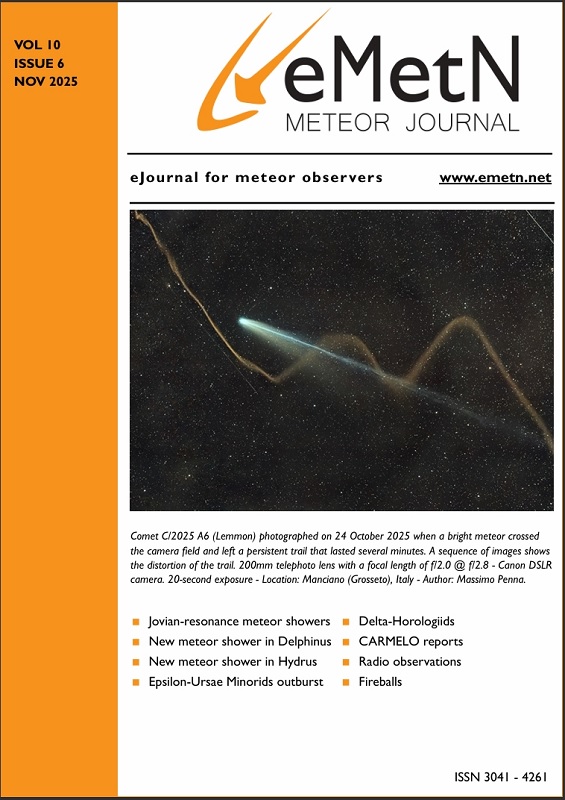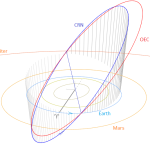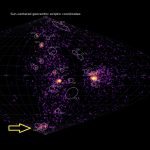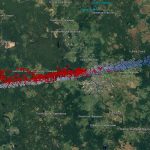As seen from the northern hemisphere, meteor rates continue to be strong in November. While no major activity is expected this month, the two Taurid radiants plus the Leonids keep the skies active. The addition of strong sporadic rates makes November one of the better months to view meteor activity from north of the equator. Skies are fairly quiet as seen from the southern hemisphere this month. Activity from the three showers mentioned above may be seen from south of the equator, but the sporadic rates are much lower than those seen north of the equator.
During this period, the Moon reaches its full phase on Wednesday, November 5th. On that date, the Moon will be located opposite the Sun and will lie above the horizon all night long. This weekend the waxing gibbous moon will set before dawn, allowing a small window of opportunity to view meteor activity under dark skies.
The estimated total hourly rates for evening observers this weekend should be near 3 as seen from mid-northern latitudes (45°N) and 2 as seen from tropical southern locations (25°S). For morning observers, the estimated total hourly rates should be near 12 as seen from mid-northern latitudes (45°N) and 6 as seen from tropical southern locations (25°S). Rates are reduced due to lunar interference.
The actual rates observed will also depend on factors such as personal light and motion perception, local weather conditions, alertness, and experience in watching meteor activity. Note that the hourly rates listed below are estimates based on observations from dark-sky sites away from urban light sources. Observers viewing from urban areas will see less activity, as only the brighter meteors will be visible from such locations.
The radiant (the area of the sky from which meteors appear to originate) positions and rates listed below are exact for Saturday night/Sunday morning, November 1/2. These positions do not change greatly from day to day, so the listed coordinates may be used throughout this entire period. Most star atlases (available online, in bookstores, and at planetariums) include maps with celestial coordinate grids that can help you locate these positions in the sky.
I have also included charts of the sky that display the radiant positions for evening, midnight, and morning. The center of each chart represents the sky directly overhead at the corresponding hour. These charts are oriented for facing south but can be used for any direction by rotating them accordingly. A planisphere or planetarium app is also useful for showing the sky at any time of night on any date of the year.
Activity from each radiant is best seen when it is positioned highest in the sky (culmination), either due north or south along the meridian, depending on your latitude. Radiants that rise after midnight will not reach their highest point in the sky until daylight; therefore, it is best to view them during the last few hours of the night.
It must be remembered that meteor activity is rarely seen directly at the radiant position. Rather, meteors shoot outward from the radiant, so it is best to center your field of view so that the radiant lies near the edge rather than the center. Viewing in this way allows you to trace the path of each meteor back to the radiant (if it belongs to a shower) or in another direction if it is sporadic. Meteor activity is not visible from radiants located far below the horizon.
The positions below are listed in west-to-east order by right ascension (celestial longitude). The positions listed first are located farther west and are therefore accessible earlier in the night, while those listed farther down the list rise later.
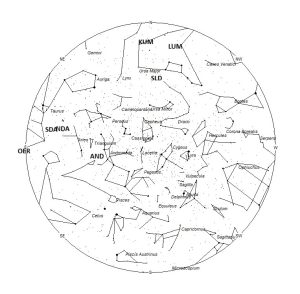
Radiant Positions at 19:00 Local Standard Time
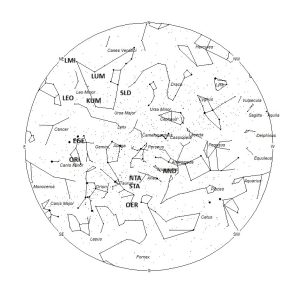
Radiant Positions at Midnight Local Standard Time
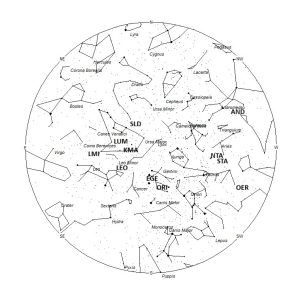
Radiant Positions at 05:00 Local Standard Time
These sources of meteoric activity are expected to be active this week
Details of each source will continue next week when viewing conditions are more favorable
The list below provides tabular information on the active showers that are within reach of the visual observer to discern. Hourly rates are often less than one, so these sources are rarely listed as visual targets in most meteor shower catalogs. If you, like me, wish to associate as many meteors as possible with known sources, you will appreciate these listings.
Before claiming to have observed meteors from these Class IV showers, you should determine whether they truly belong to them and are not chance alignments of sporadic meteors. Note parameters such as duration, length, radiant distance, and elevation of each meteor to help compute the probability of shower association.
It should be remembered that slow meteors can appear in fast showers, but fast meteors cannot be produced by slow showers. Slower showers are those with velocities less than 35 km/sec. Slow meteors can appear from fast showers when they occur close to the radiant or low in the sky.
The table located on page 22 of the IMO’s 2025 Meteor Shower Calendar is a helpful tool for identifying meteors. If you record the length and duration of each meteor, you can use this chart to check the probability of the meteor belonging to a shower of known velocity. If the angular velocity matches the figure in the table, your meteor probably belongs to that shower.
Recognizing meteors from obscure showers is not for beginning meteor observers—it takes many hours of practice to develop an instinct for what you’re seeing. It is our hope that you will move beyond simply watching meteors as a celestial fireworks display and help expand our knowledge of these heavenly visitors by classifying each meteor you observe.
Rates and positions in the table are exact for Saturday night/Sunday morning November 1/2.
| SHOWER | DATE OF MAXIMUM ACTIVITY | CELESTIAL POSITION | ENTRY VELOCITY | CULMINATION | HOURLY RATE | CLASS |
| RA (RA in Deg.) DEC | Km/Sec | Local Standard Time | North-South | |||
| Andromedids (AND) | Nov 06 | 01:12 (018) +20 | 20 | 23:00 | <1 – <1 | IV |
| omicron Eridanids (OER) | Nov 05 | 03:04 (046) +01 | 30 | 01:00 | <1 – <1 | IV |
| Northern Taurids (NTA) | Nov 09 | 03:04 (046) +20 | 30 | 01:00 | 2 – 1 | II |
| Southern Taurids (STA) | Nov 05 | 03:13 (048) +14 | 31 | 01:00 | 3 – 2 | II |
| Orionids (ORI) | Oct 23 | 06:36 (099) +16 | 66 | 04:00 | 1 – <1 | I |
| epsilon Geminids (EGE) | Oct 16 | 07:12 (108) +27 | 68 | 05:00 | <1 – <1 | IV |
| rho Puppids (RPU) | Nov 08 | 07:20 (110) -25 | 58 | 05:00 | <1 – <1 | IV |
| kappa Ursae Majorids (KUM) | Nov 05 | 08:52 (133) +49 | 66 | 06:00 | <1 – <1 | IV |
| Leonids (LEO) | Nov 17 | 09:20 (140) +30 | 69 | 07:00 | 1 – <1 | I |
| Southern lambda Draconids (SLD) | Nov 03 | 09:44 (146) +73 | 50 | 08:00 | <1 – <1 | IV |
| Lambda Ursa Majorids (LUM) | Oct 28 | 10:24 (156) +50 | 61 | 09:00 | <1 – <1 | IV |
| Leonis Minorids (LMI) | Oct 22 | 10:56 (164) +36 | 61 | 10:00 | <1 – <1 | II |
You can keep track of the activity of these meteor showers as well as those beyond the limits of visual observing by visiting the NASA Meteor Shower Portal. You can move the sky globe to see different areas of the sky. Colored dots indicate shower meteors while white dots indicate sporadic (random) activity. The large orange disk indicates the position of the sun so little activity will be seen in that area of the sky.
Class Explanation: A scale to group meteor showers by their intensity:
- Class I: the strongest annual showers with Zenith Hourly Rates normally ten or better.
- Class II: reliable minor showers with ZHR’s normally two to ten.
- Class III: showers that do not provide annual activity. These showers are rarely active yet have the potential to produce a major display on occasion.
- Class IV: weak minor showers with ZHR’s rarely exceeding two. The study of these showers is best left to experienced observers who use plotting and angular velocity estimates to determine shower association. These weak showers are also good targets for video and photographic work. Observers with less experience are urged to limit their shower associations to showers with a rating of I to III.

